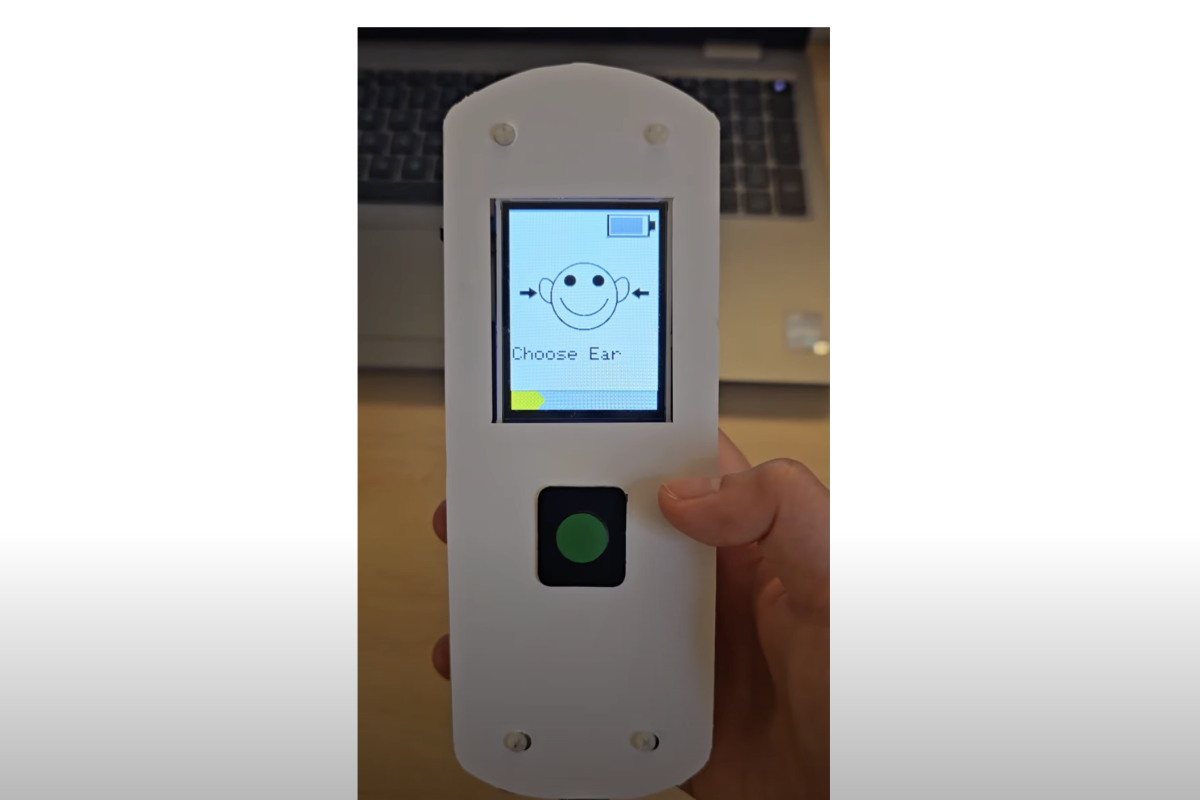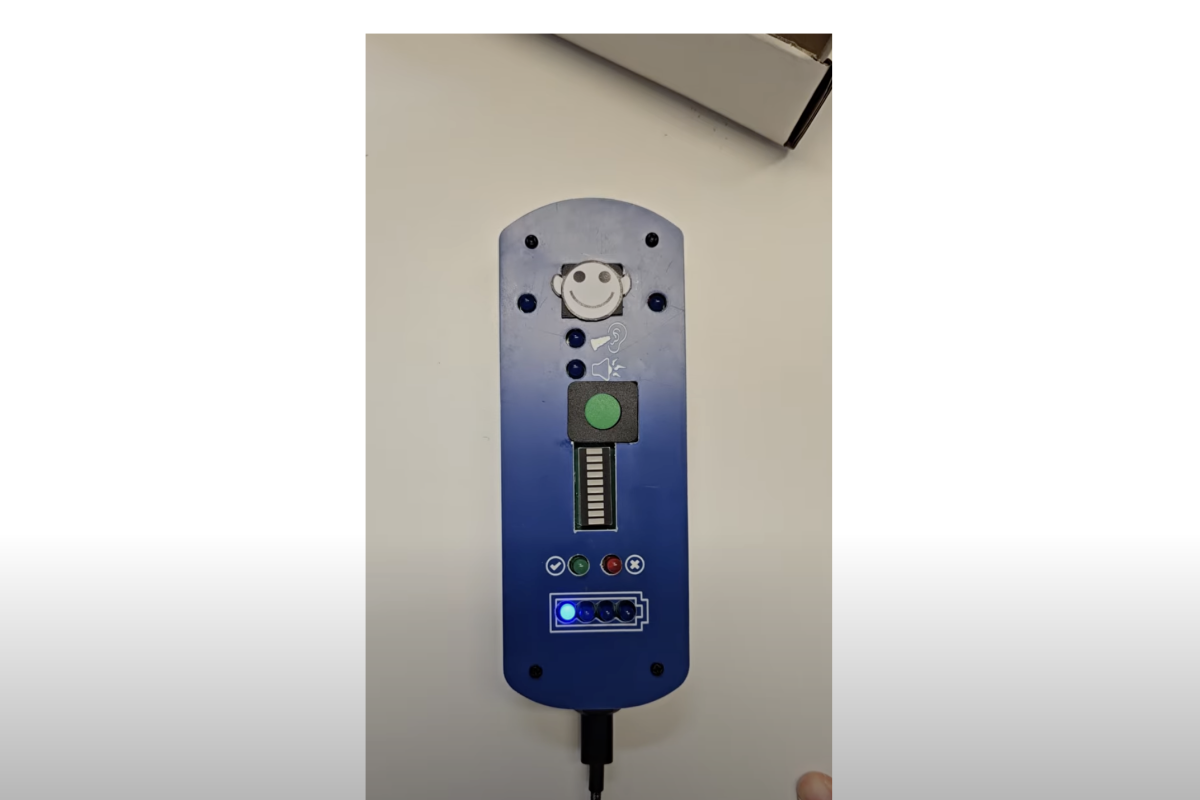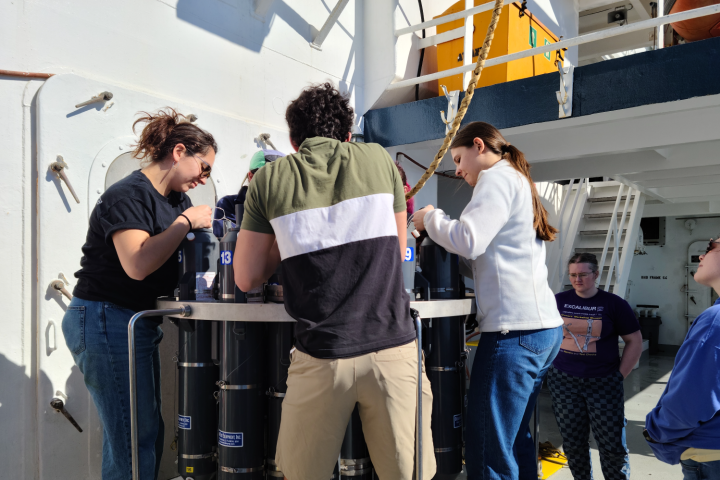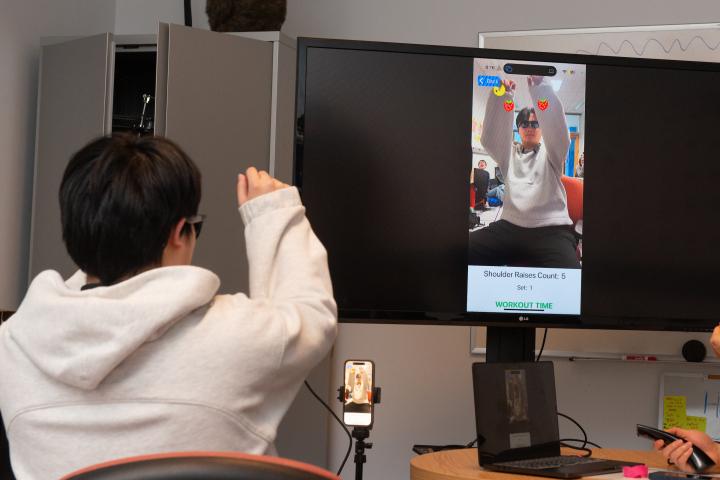STORY: Student Researchers Expand Access to Early Hearing Loss Detection with Smart Design
Student researchers at Olin College worked this summer with faculty from Olin and Boston College to develop two reprogrammable user interface prototypes that support early detection of hearing loss in children - improving access to care around the world. (Watch video)
The research is part of the Design Justice Studio (*previously ADE) project, Early Hearing Loss Detection for Improved Life Outcomes, where Oliners are collaborating with audiologists from Smiles that Listen Foundation, Guatemala, and community partners in Massachusetts, to develop an affordable, effective childhood hearing screening tool.
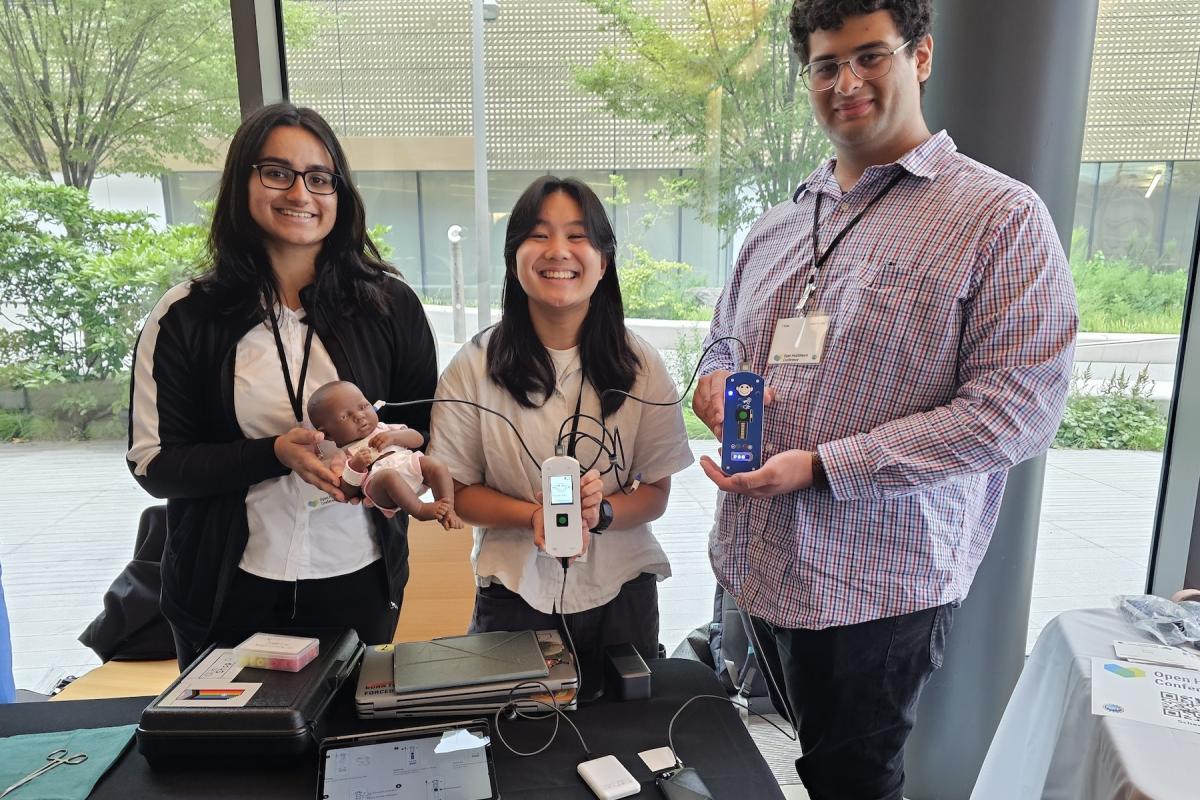
Olin researchers are pictured demonstrating their reprogrammable user interface prototypes that support early detection of hearing loss in children at the Open Healthware Conference in New York City.
(L to R): Antara Mazumdar '28, Arianne Fong '27, and Albert Manrique '25.
Designing for Impact: A Student-Powered Global Effort
The Early Hearing Loss project is advised by Elizabeth Johansen, senior lecturer in design and biomedical engineering, Bradley Minch, professor of electrical and computer engineering, and Boston College's Siddhartan Govindasamy, professor of engineering, and Sabet Family Dean's Endowed Faculty Fellow. The project's funding comes from EPICS in IEEE, The Peabody Foundation, Inc, and an anonymous Olin alum.
Multiple students since 2019 have worked to bring the project to life. Whether through engineering capstones or summer research, students have used their technical electrical engineering skills alongside design thinking to make a positive impact on children in low- and middle-income communities around the globe where the primary barriers to hearing screening are cost and usability.
This summer, three Olin College electrical and computer engineering (ECE) majors worked as research assistants on the project, tackling the interface design of the screening device and working to ensure future Oliners can easily update the firmware.
The researchers, Arianne Fong '27, Albert Manrique '25, and Antara Mazumdar '28, also see this open source project as an important way to impact people and the world while doing the engineering they love.
"This project combines engineering with stakeholders, impactful work, electrical engineering, and human-centered design – all things I care about and enjoy doing!" says Arianne.
An ear icon is shown on the screen display of the team's LED with icons version prototype.
From conversations with global partners and insights they've gathered into newborn hearing screenings, the team says the value of the tool their designing is clear.
"I’m really excited about the idea of this screening device being fully developed and used in the field, and I want to be a part of making it happen!" says Arianne.
Albert, an Olin alum and researcher on the team, agrees. "It's a great opportunity to bring higher quality care to people who need it around the globe. When I applied to Olin I always wanted to contribute to creating an affordable health product, so this project specifically, and its goal, is a great opportunity to make that happen."
The two physical user interfaces (UI) developed by the students increases that accessibility and affordability and serves a secondary aim.
"This project combines engineering with stakeholders, impactful work, electrical engineering, and human-centered design – all things I care about and enjoy doing!" says Arianne Fong '27, research assistant.
"Open source healthware serves the dual purpose of making healthcare more accessible and affordable and it enables people to directly contribute to the work," says Antara, a first-year student. That direct collaboration fosters greater technological knowledge and encourages experimentation.
"Olin’s project-driven education and ability to impact people directly drew me to the research and I'm grateful I have the opportunity to work on a project like this that'll be used by healthcare professionals in Guatemala and Boston, and beyond!"
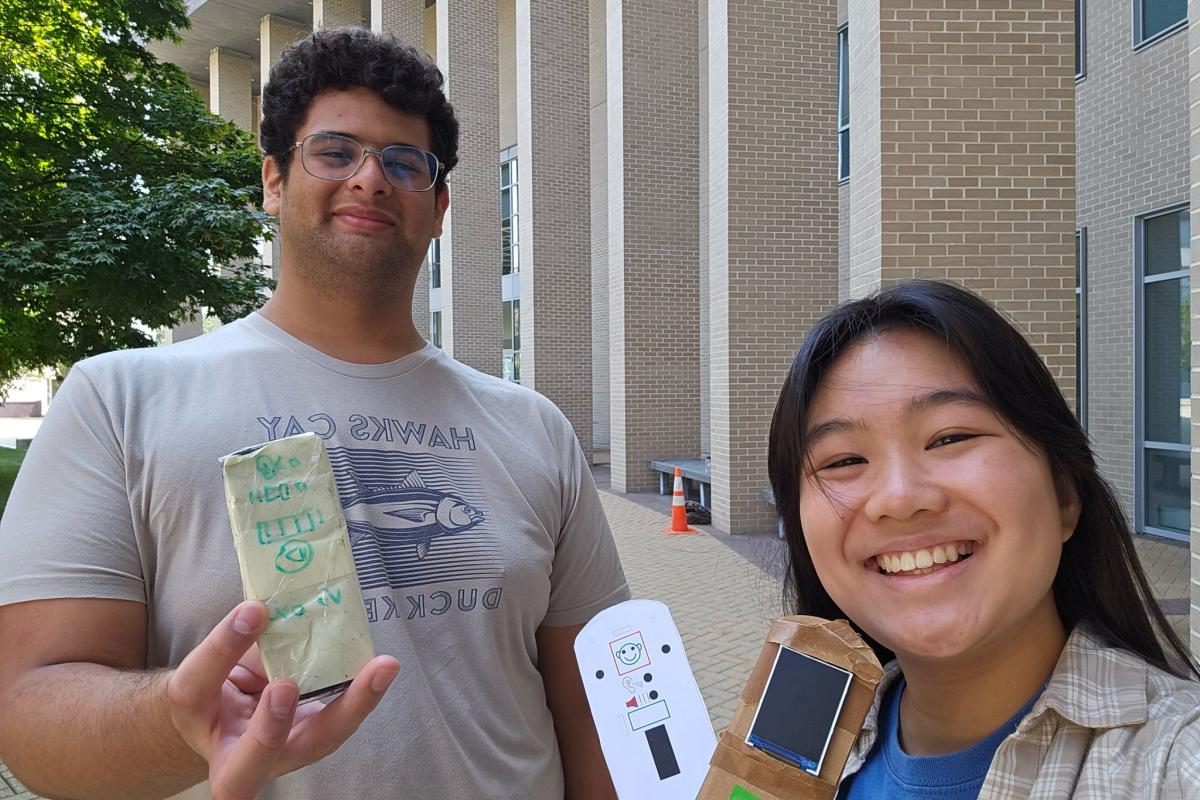
Research assistants, Albert Manrique '25, electrical and computer engineering (ECE) graduate, and Arianne Fong '27, ECE major, are pictured holding up their early stage UI prototypes. The Oliners worked over the summer to develop two reprogrammable hearing testing device user interface prototypes. Also on the research team is Antara Mazumdar '28 (not pictured).
Dual Prototypes Take Shape
The summer researchers developed two prototypes while also researching how they could make the project open source to enable collaboration and to provide access to communities worldwide.
"Arianne and Albert, with help from Antara, designed and built our first field-reprogrammable user interface prototypes, mailed them to our collaborators in Guatemala, and used them in a virtual codesign," says Elizabeth Johansen, project advisor.
"This is a huge step forward in our user interface design as it will allow future students to send updated firmware that alters the user interface and then get additional feedback," Johansen adds.
In terms of the prototypes, you can hold them in your hand, and while they don’t run the hearing screening test, they look like they do.
"This design allows people to interact with it as if they’re conducting a hearing screening, helping us understand how to make the device more useful and easier to operate correctly. We also designed these prototypes to test a handful of assumptions," Arianne says.
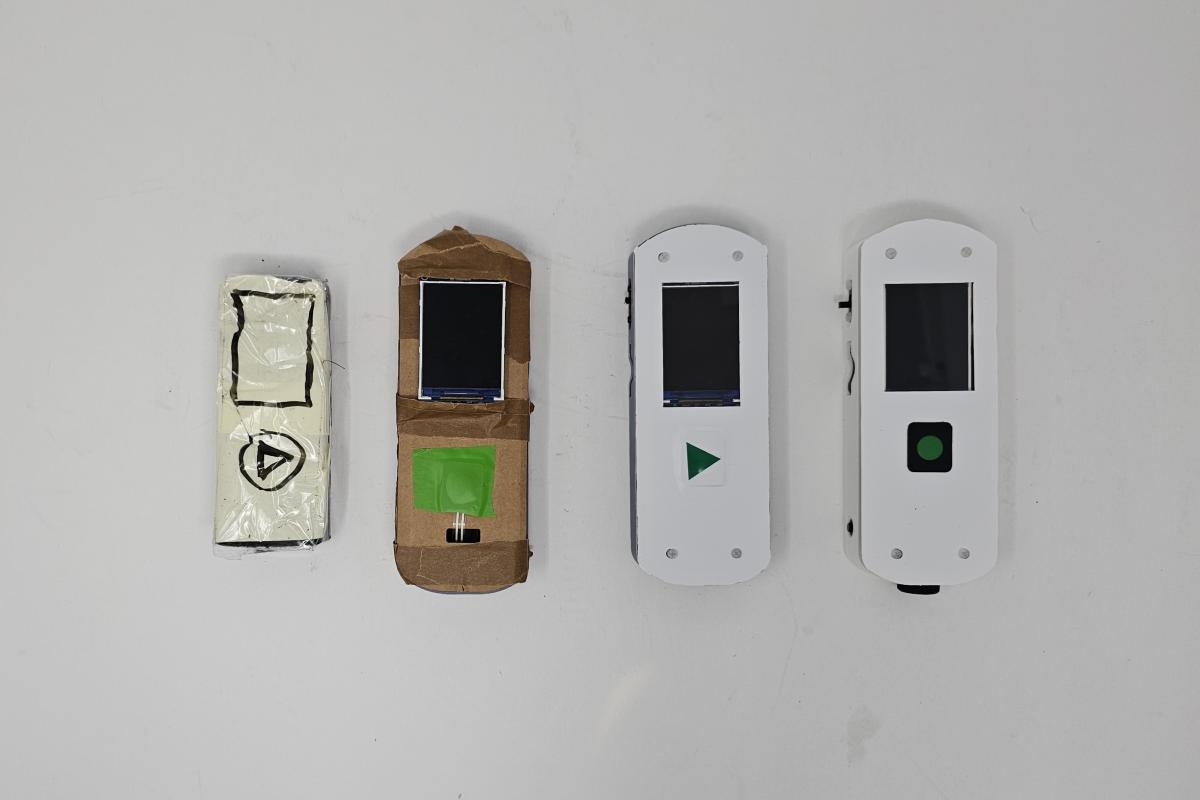
The student-designed UI prototypes (screen display versions) are pictured on a white background.
One of those assumptions was whether a graphical based interface with an LCD screen or an icon based prototype with LED indicators would be a more effective UI.
Having the two different prototypes allowed the team to conduct A/B testing, comparing the UI features of one prototype against the other. This helped them to understand what worked, what didn't, and why.
"We ideated potential designs as a team using whiteboards, sticky notes, and sketch models to see what it might be like to hold the design in our hands. Once we decided on the designs, we went ahead and built them," says Arianne.
The Oliners first found compatible components, designed printed circuit boards (PCBs), assembled the PCBs by soldering components on them, laser cut and 3D printed the cases, integrated the components, and wrote code to bring it all to life.
"In order to get more of a finished look (as far as prototypes go) we used 3D printing and laser cutting to make our enclosures. The Olin Shop was a great resource for us as we weren’t limited to any one form of manufacturing and we had tons of material selection support from them!" says Albert.
"This is a huge step forward in our user interface design as it will allow future students to send updated firmware that alters the user interface and then get additional feedback," says Elizabeth Johansen, project advisor and senior lecturer in design and biomedical engineering.
Working hands-on allowed the team to really flex their technical know-how.
"I was able to practice and hone my soldering and PCB assembly skills through this project, as well as to better understand microcontrollers and integrating input methods like tactile buttons and LCD displays," says Antara.
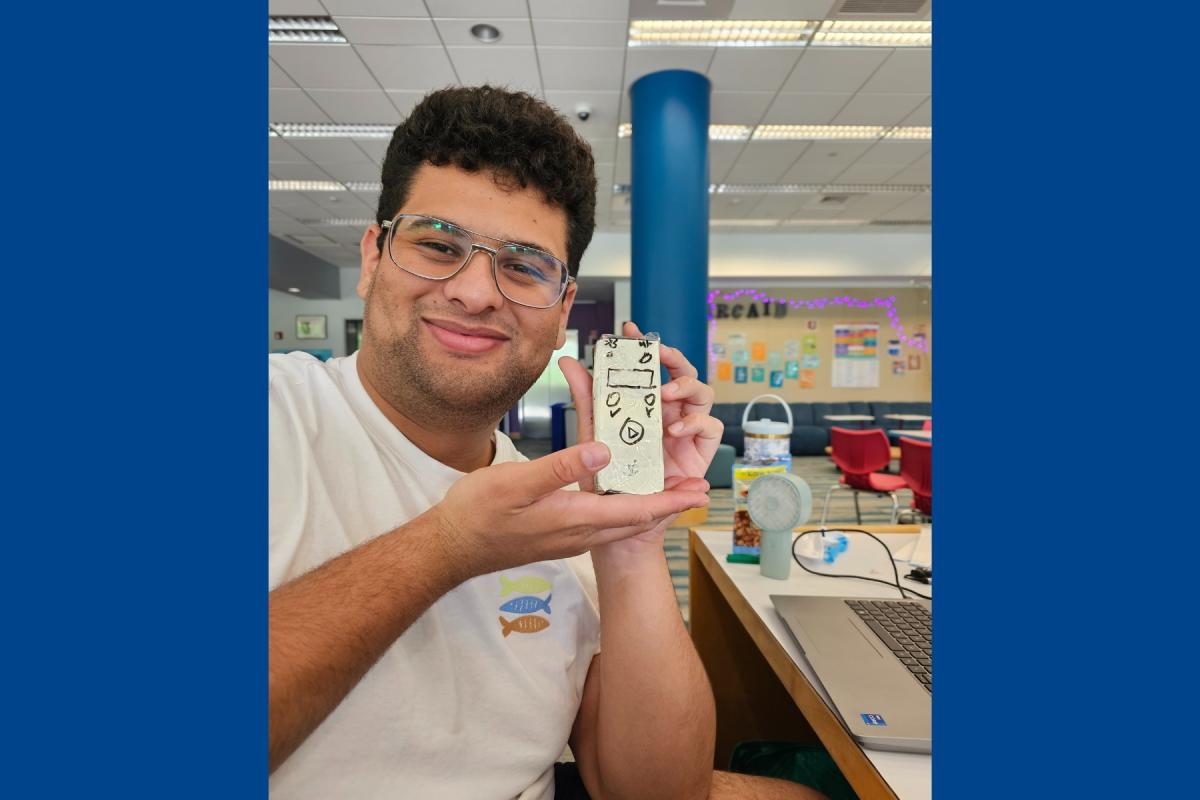
Albert Manrique '25 is pictured at Olin holding up one of the early stage user interface prototypes.
For Antara and Arianne, the summer research built directly on their coursework, giving them the chance to apply what they've learned in a real-world context.
"While my Products & Markets (P&M) class has given me a solid introduction, through this project I was able to interact directly with user input, better understanding what the use cases and requirements were, and provided insights in the codesign of our final prototypes," says Antara.
Arianne confirms it, adding the experience felt like a culmination - bringing together knowledge from different parts of the Olin journey into one practical application with direct impact. "I’ve really enjoyed taking what I’ve learned from previous courses, research experiences, and conversations, and getting to apply it to a real project, developing a real product with real stakeholders."
"I’ve really enjoyed taking what I’ve learned from previous courses, research experiences, and conversations, and getting to apply it to a real project, developing a real product with real stakeholders," says Arianne Fong '27.
For Albert, the experience not only provided the opportunity to achieve the goal of creating an affordable health product at Olin, but also allowed valuable time to concentrate on the intricacies of the work.
"It’s fantastic, I could really take my time with the whole project and slow down to take care of the finer details that I wouldn’t find the time to in a similar project during the year."
Building Together: Open Source for Better Health
For this year's Oliners to get their own feedback and inspiration for the project, the trio attended Open Source Hardware Association's (OSHA) first-ever Open Healthware Conference August 1-2 in New York City.
"Everyone at the conference was really supportive, and it was inspiring to hear about other open source hardware in healthcare projects such as hearing amplifiers and 3D printed torniquets. We were also able to run demos of our physical UI prototypes, letting attendees try our device and sharing our project with them," says Arianne.
Looking back on the summer’s work, the students were inspired not only by their own progress but also by the broader community that has shaped this project over the past 6 years.
"As part of my research, I reached out to some Olin alumni who previously worked on this project. It was deeply encouraging to hear from them and to see their excitement for the current direction of the project," Arianne says.
To-date the project team has co-designed with over 30 people from 15 countries in pursuit of the intuitive user interface usable by people in Massachusetts, Guatemala, and around the globe.
